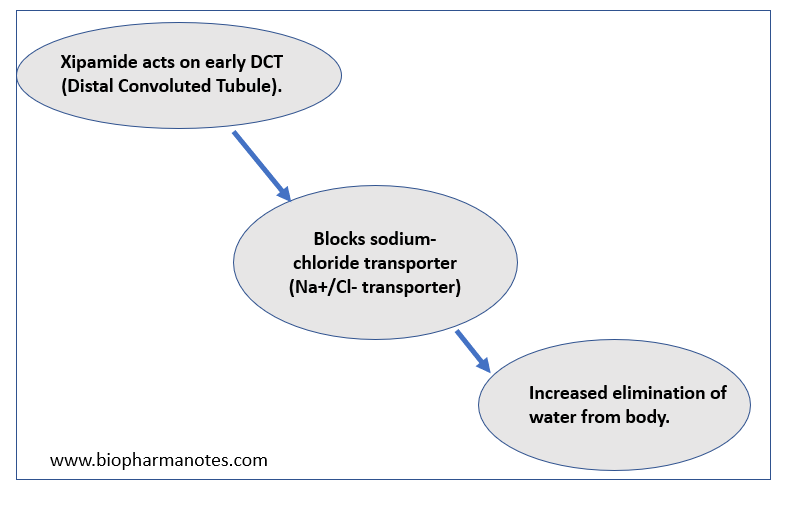
- Xipamide is sulfonamide– based diuretic. Diuretics are drugs which are commonly used to promote diuresis or water loss by increasing urine production Chemically, it is 4-chloro-5-sulfamoyl- 2’- 6’- salicyloxlidide. It is diuretic derived from salicylic acid.
- It resembles thiazide diuretics in hypotensive effect and adverse effects and resemble furosemide diuretics as it is useful in patients with renal failure. Its diuretic efficacy is similar to furosemide at doses upto 40 mg and onset and duration of action are similar to those of hydrochlorothiazide. However, it neither belong to furosemide nor thiazide diuretics.
Indications of xipamide
- Used in treatment of hypertension and edema in normal patients and in patients with renal failure. It can be used as suitable alternative for other diuretics.
- It is effective even in patients with end stage kidney disease.
Mechanism of action of xipamide

Figure- Mechanism of action of Xipamide
- It mainly acts on central dilating section of early distal convoluted tubule (DCT) of nephron, binds to Na+ Cl– symporter and block sodium-chloride transporter (Na+/Cl- transporter). Thus, it inhibits reabsorption of sodium and chloride ions resulting in increased elimination of water from the body. As more water is eliminated from body, heart works less to pump blood around the body thus lowering the required blood pressure.
- It increases diuresis, natriuresis and kaliuresis. It decreases Ca+ excretion and increases Mg+ excretion.
Pharmacokinetics of xipamide
- It is administered via oral or IV route. The onset of action begins in 1-2 hours. Its half-life is around 7-8 hours. It’s half-life is only slightly prolonged in patients with renal failure compared to patients with normal renal function. Hence, there is no accumulation of xipamide in renal patients and is safe to use in them.
- Most of the administered xipamide is excreted in urine and small percentage is excreted via feces. Its metabolite is xipamide-O-glucuronide.
- Recommended dose is 20-40 mg/ day as a single dose.
Adverse effects
- It can cause dizziness, GI disturbances, ototoxicity and nocturia. It can also cause hypokalemia. Some cases of severe hypokalemia with ventricular arrhythmia is also reported.
- As it has kaliuretic effect, serum concentration of K+ should be continuously monitored. Concurrent administration of potassium supplements or potassium sparing diuretics (spironolactone) is recommended.
Drug Interactions
- Concurrent administration of other drugs like ACE inhibitor, alcohol and barbiturates may increase its antihypertensive effect.
- It decreases excretion of lithium resulting in increase in side effects of lithium.
Contraindications
- Contraindicated in following conditions:
- In patients hypersensitive to xipamide or other sulfonamides.
- In pregnancy and breastfeeding women.
- Patients with hyperuricemia, hypercalcemia and Addison’s disease.
- In case of hypovolemia, hyponatremia and hypokalemia.
References
- https://pubchem.ncbi.nlm.nih.gov/compound/26618
- https://en.wikipedia.org/wiki/Xipamide
- https://www.medicineindia.org/pharmacology-for-generic/675/xipamide
- Kramer et al. Xipamide. Cardiovascular Drug Reviews. 1988; 6(2): 141-154.
- Prichard BN et al. Drugs. Xipamide. A review of its pharmacodynamic and pharmacokinetic properties and therapeutic efficacy. 1985; 30(4): 313-32.
- Pharmacology and pharmacotherapeutics. 24th edition.
- Essentials of Medical Pharmacology. 7th edition.